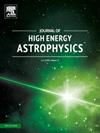Neutron star analysis under f(R,G,Lm) gravity model
IF 10.5
4区 物理与天体物理
Q1 ASTRONOMY & ASTROPHYSICS
引用次数: 0
Abstract
The modified Tolman-Oppenheimer-Volkoff (TOV) equations for compact stars in the setting of gravity are derived and numerically solved in this paper, specifically using the functional formulation . Both quark and hadronic matter, which are characterized by physically accurate equations of state, are taken into consideration while analysing different values of the free parameter α. The influence of α on the properties of these specific stars is examined. The concluding remarks encapsulate the principal discoveries, highlighting their significance and alignment with observational data derived from the neutron star in . To account for two different possibilities of the matter Lagrangian density, the study modifies the stellar structure equations by considering (where p denotes the pressure) and (where ρ represents the density), allowing for accurate and reliable numerical simulations and further analysis. As expected, when , the traditional TOV equations of Einstein's gravity are recovered. The results indicate that the two distinct options, as, and , lead to markedly different outcomes on the mass-radius diagrams. In summary, this research advances our comprehension of the way gravity affects neutron star interior structures. By providing insightful observations, it lays the groundwork for future studies and investigations in this field.
f(R,G,Lm)引力模型下的中子星分析
本文推导了f(R,G,Lm)重力条件下致密星的修正Tolman-Oppenheimer-Volkoff (TOV)方程,具体采用泛函式f(R,G,Lm)=R+αGLm进行了数值求解。在分析自由参数α的不同值时,考虑了具有物理精确状态方程特征的夸克和强子物质。研究了α对这些特殊恒星性质的影响。结束语概括了主要的发现,强调了它们的重要性,并与NGC6397中子星的观测数据进行了对比。为了解释物质拉格朗日密度的两种不同可能性,该研究通过考虑Lm=p(其中p表示压力)和Lm=−ρ(其中ρ表示密度)来修改恒星结构方程,从而允许精确可靠的数值模拟和进一步的分析。正如预期的那样,当α→0时,恢复了爱因斯坦引力的传统TOV方程。结果表明,Lm=p和Lm=−ρ两种不同的选择在质量-半径图上导致了显著不同的结果。总之,这项研究促进了我们对f(R,G,Lm)引力影响中子星内部结构方式的理解。通过提供有见地的观察,为该领域未来的研究和调查奠定了基础。
本文章由计算机程序翻译,如有差异,请以英文原文为准。
求助全文
约1分钟内获得全文
求助全文
来源期刊

Journal of High Energy Astrophysics
Earth and Planetary Sciences-Space and Planetary Science
CiteScore
9.70
自引率
5.30%
发文量
38
审稿时长
65 days
期刊介绍:
The journal welcomes manuscripts on theoretical models, simulations, and observations of highly energetic astrophysical objects both in our Galaxy and beyond. Among those, black holes at all scales, neutron stars, pulsars and their nebula, binaries, novae and supernovae, their remnants, active galaxies, and clusters are just a few examples. The journal will consider research across the whole electromagnetic spectrum, as well as research using various messengers, such as gravitational waves or neutrinos. Effects of high-energy phenomena on cosmology and star-formation, results from dedicated surveys expanding the knowledge of extreme environments, and astrophysical implications of dark matter are also welcomed topics.
 求助内容:
求助内容: 应助结果提醒方式:
应助结果提醒方式:


